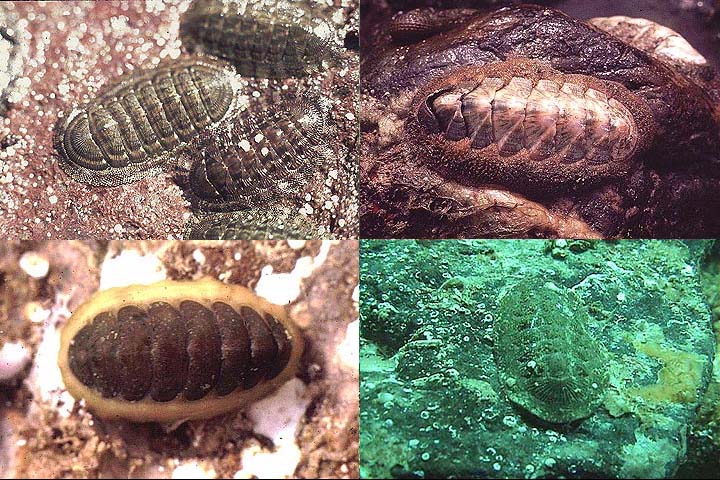

Occasionally when I turn over rocks while diving, I find a primitive mollusc known as a chiton. Of course once I film these critters, I carefully return the rock to its proper place. As a group, chitons or "sea cradles" have been around for nearly 500 million years, slightly longer than myself. They have eight loose calcium carbonate plates or valves rather than a single snail-like shell for protection. This allows them to roll up for protection just like an armadillo if they are detached from the rocks. The hard plates are embedded in the fleshy tissue extending beyond the edges of the valves. This exposed body tissue is called the mantle. Like snails, these critters crawl over or adhere tightly to the rocks using a muscular foot. Sizes of different species may range from 1/2" to over a foot in the gumboot chiton, the world's largest species.
Like many snails, chitons use a rasp-like "tongue" known as a radula to scrape algae and other food from the rocks. Different species are vegetarians, omnivores or scavengers. Some species have diets where animal matter is half their diet. Others may specialize on only a few different species of algae. You can often see the radula's scratch marks left on certain types of encrusting algae after they've fed. Scientists discovered that the chiton's radula is often hardened with the iron-based mineral magnetite which the chitons create by themselves... kind of like eating with stainless steel rather than plastic utensils.
Some chitons feed primarily at night, remaining affixed to its home spot or "scar" during the day like some abalone They usually return to this same protected spot before morning to avoid predators. One species actually settles in depressions in the rock, assuming the shape of that particular "hole" as it grows. These depressions offer protection from predators and also trap potential food particles for the chiton to eat. Predators may include starfish, carnivorous snails and even seagulls (on those in the intertidal).
Although they hardly look edible, Native Americans in our region centuries ago used some of the larger chitons like the gumboot for food. Fragments of their shells have been observed in the middens or trash dumps of these early residents. These chitons are largely absent from our region today, probably due to the natural warming of our ocean waters rather than over-fishing by the tribes. However, middens on our own island have revealed evidence of over-fishing of similar species including abalone and wavy top snails by the natives, forcing them to move to new locations. Fortunately these natives lacked SCUBA gear which would have allowed them to exploit the deeper water reserves which eventually replenished the shallower waters. Ed "Doc" Ricketts, my marine biologist "icon" of "Cannery Row" fame, is said to have eaten one and decided it should be on the menu only during times of extreme famine
The sexes are separate in chitons. Rather than indulging in yucky old-fashioned sex, they merely cast their sperm and eggs into the water where some get fertilized. Like true "gentlemen," the males go first and the females follow suit when they detect sperm in the nearby water. The successful ones spend some time drifting in the plankton dispersing to new areas until they settle to the bottom and begin their adult life. Their time in the plankton may be as little as 15 minutes or as long as days or weeks. However, there are a few species that brood the fertilized eggs in a groove next to the foot and lack a planktonic stage. These species most likely have higher survival rates and can produce fewer eggs, but they lack a dispersal stage to easily colonize new areas.
When I turned over the rock to expose my most recent chiton, it soon began crawling to get out of the sunlight. This is a response known as "negative phototaxis" or movement away from light. Many chitons exhibit this reaction. You might say these chitons are attracted to the "Dark Side" like Darth Vader. This light sensitive reaction assures that these chiton will seek protection under rocks rather than on the exposed surface where they might become food for a sheephead or starfish (or an easy subject for me to video).
© 2004 Dr. Bill Bushing. Watch the "Dive Dry with Dr. Bill" underwater videos on Catalina Cable TV channel 49, 10:00 AM and 5:00 PM weekdays.

Chitons of different species found in our area. The
one in the
lower right is crawling towards the dark side of the
rock.
This document maintained by
Dr. Bill Bushing.
Material
© 2003 Star Thrower Educational Multimedia